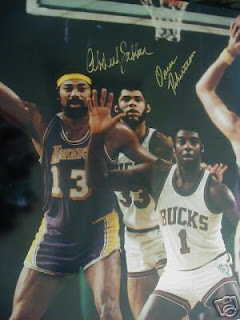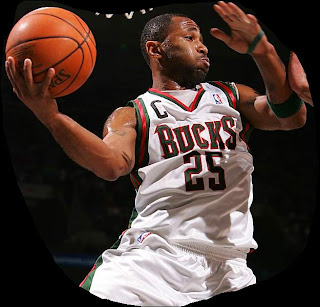Alright, I promised it and so here it is: Bucks Diary's first and probably last ever NCAA bracket helper (trying to analyze college basketball is like trying to analyze the weather with your finger).
The Logic
I did two seperate analysis of the field of 64 based on the following logical beliefs:
1. The belief that, as established by Dean Oliver and countless others, wins and losses in basketball are strictly a function of offensive and defensive efficiency;
2. My own belief that, because of the inordinately strong "home court advantage" in the sport of basketball, team strength is best revealed on the road; and,
3. You have to try everything you can to neutralize the wild fluctuations in schedule strength that are inherent in the college game -- both absolute strength and home/road strength.
Here's what I didI have, basically, three seperate analysis packed into two seperate charts. The first chart, I'll call the "
Win Score" analysis is here:
Click here to see "Win Score" analysisHere's what's going on there. For each team I did four seperate Win Score per game analysis: (1) Overall Offensive Win Score; (2) Offensive Win Score on the road; (3) Defensive Win Score; and (4) Defensive Win Score on the road. I then averaged the Offensive and Defensive numbers (since NCAA tournament games are "neutral" site, I figured that the team's would perform somewhere in between the way they perform in front of entirely friendly crowds and entirely hostile crowds. Indeed, if you look at home/away/neutral scoring breakdowns, there is evidence to support that theory.)
After averaging them, I calculated their percentage difference from the collegiate mean of 35.0 Win Score points per game. I then adjusted that number according to their opponent's offensive and defensive efficiency variations from the collegiate mean (101.5 pts/100 possessions), then I did some dirty math to adjust for road strength: I arbitrarily gave each team an extra 4 points for every road game against a Top 25 team, and 2 points for every road game against a Top 25-50 team. (I did that because there was NO WAY I was going to calculate each team's absolute road schedule strength. I put too much time into this shit as is.)
Second AnalysisNot completely satisfied with that, I did a second analysis I will call the "Mixed Analysis". This one contains the surplus of the Win Score numbers I referred to above, plus each team's "Point Value over Average" -- which is very similar to
basketball-reference.com's "Simple Rating System" except it uses efficiency numbers instead of actual points scored. I then added those numbers together and adjusted them for road strength by multiplying them by 1 plus the team's "Away RPI" and then adjusted them for Strength of Schedule by multiplying that result by 1 plus the team's "Strength of Schedule".
Click here to see the "Mixed Analysis"I think that by itself "Point Value over Average" is a pretty good evaluator, because, in theory, it is schedule neutral. The only thing it doesn't account for is "location". Some teams, like Tennessee and Arizona, play a schedule weighted with difficult road opponents, whereas teams like Memphis play nearly all of their most challenging opponents at home. That makes a big difference, and "Point Value over Average" doesn't account for that difference. But with that caveat in mind, I think it can still serve as a useful analytical tool standing alone.
My best guessesIts been proven by someone (I forgot the guy's name) that seven game series are an inadequate way to distinguish superior teams, so the college "one/off" method is, a lot of times, an absolute toss-up. That said, here are my best guesses (I'm assuming away all of the 1-16 games, btw):
Indiana vs. Arkansas:All the numbers say Indiana. In my mixed analysis (hereafter "MA") Indiana holds a 144.3 to 96.6 advantage. In the WS analysis, its Indiana 71.7, Arkansas 50.2. On the straight PVOA comparison, its Indiana 26.7, Arkansas 20.2. And Indiana has the better Away RPI. The problem is, Indiana is in turmoil. Nevertheless, I'm holding with the numbers and taking Indiana.
Notre Dame vs. George Mason:Notre Dame is an awful road team. They would be vulnerable against any decent competition. Unfortunately, George Mason is not it. The pick goes to ND.
Washington St vs. Winthrop:Not this year, Winthrop. Tony Bennett's boys are just too strong, and Winthrop is much weaker than last year's edition. The pick goes to Washington State.
Oklahoma vs. St. Joseph'sUpset alert, No. 1. I think St Joe's can take down the Sooner. In my MA, its close, with SJU holding a 114.9 to 108.9 advantage. In my WS, Oklahoma edges out SJU 60.3 to 58.0. In PVOA, its Oklahoma again, 22.2 to 17.2. But SJU has the better overall Win Score, and in "one-off" matchups, big offensive teams always have a "puncher's chance", and SJU's projected Neutral Site WS offense is an above average 38.5. This one's just a hunch, so buyer beware.
Louisville vs. Boise State:Louisville is one of the strongest teams in the field. Boise State is not, but they do have an explosive offense. That said, there is no way they should beat Louisville.
Butler vs. South Alabama:Another tough call. Butler is not all they are cracked up to be. They haven't beaten anyone of note on the road all year. UWGB almost took them out in GB, and the same with UWM. But they do have a lock down defense. The WS edge goes to South Alabama, 41.5 to 37.7. The MA edge goes to Butler, 108.7 to 98.4. The PVOA edge goes to Butler 22.0 to 14.4. But the Away RPI edge goes to South Alabama, and they had basically had even schedule strengths. I'm going to hold my breath and go offense, so the pick here is South Alabama, but again, Buyer Beware.
Tennessee vs. American:Ahh, Tennessee.
UNLV vs. Kent State:"Tin Soldiers and Nixon's coming..." I've got Kent State here. They take the WS analysis 37.7 to 26.5. They take the MA analysis 86.2 to 69.1. UNLV does have the better SOS, Away RPI (even though they haven't beaten anyone, and their Away Win Score combined average is in the negative numbers), and PVOA (17.0 to 14.5), but I'm going to take Kent State on a hunch (this is why I finish last every year... I have a penchant for climbing out on unsturdy limbs).
Clemson v. Villanova:Villanova is a fashionable pick, but I don't see it. Clemson throttles them on my board: MA (153.7 to 77.8) WS (73.5 to 49.9) and PVOA (26.4 to 17.1). The pick here is Clemson.
Vanderbilt vs. Siena:Vandy is so ripe to be had, but not by Siena. There just too bad.
USC vs Kansas State:The big celebrity matchup. But USC should win easily. Kansas State is a terrible team away from their home gym, and they come into the tournament on a losing romp, whereas USC looked impressive against UCLA. The Trojans are the pick.
Wisconsin v. Cal State Fullerton:Bucky drew a little bit of a scary matchup. Cal State can fill the hoop. But they play no interior defense, so, Wisconsin had better win.
Gonzaga vs Davidson:This is a tough one. I initially liked Davidson as an upset, but he signs all point toward Gonzaga (I'm speeding this up so I can get to bed).
Mississippi St vs Oregon:This is kind of close, but the numbers all say Mississippi State, so that's the way I have to go.
Michigan State vs. Temple:State is just an awful road team. Even so, the numbers are all decisively in their favor, so I'm picking them.
Pittsburgh vs. Oral RobertsPittsburgh won't get far, but they will get past Oral Roberts. I don't like Pitt that much though.
Marquette vs KentuckyWhy is everyone saying this will be a tough game for the Kett? On my charts, Kentucky looks atrocious. If Kett doesn't wax them, changes need to be made on Wisconsin Avenue.
Okay, from this point I'm only analyzing games that are close calls, all others assume the higher pick. I'll do the rest of the rounds tomorrow.
Miami vs. St. Mary'sAnother upset special. Every one of my numbers says its St. Mary's. Miami is another negative Win Score road team, and that is always the profile of an upset victim.
Brigham Young vs. Texas A&MBrigham is the higher seed, but my numbers go to Texas A&M. But this one scares me... the Aggies are a very bad road team. Very bad. But I have to take them.
Purdue vs. BaylorAll of the numbers here are DEAD even. With that being the case, I'm going to take the offensive team, Baylor, in a mild upset.
West Virginia vs ArizonaI don't hate West Virginia, but my numbers love the team with the sorry record, Arizona. By my reckoning, Arizona played the toughest schedule in the country. Too bad they couldn't win too many. But I have to abide by the numbers, and they say Arizona is a strong pick, but so is West Virginia. I'm going to play a hunch and go with Arizona.
More tomorrow...





